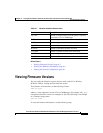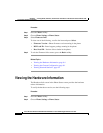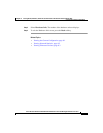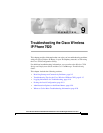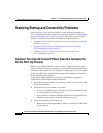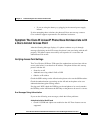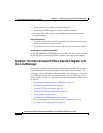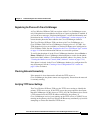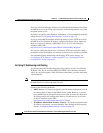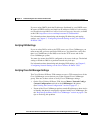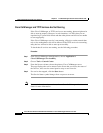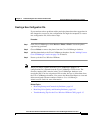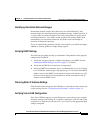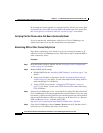
9-5
Cisco Wireless IP Phone 7920 Administration Guide for Cisco CallManager Release 3.3 or Later
OL-3930-02
Chapter 9 Troubleshooting the Cisco Wireless IP Phone 7920
Resolving Startup and Connectivity Problems
Registering the Phone with Cisco CallManager
A Cisco Wireless IP Phone 7920 can register with a Cisco CallManager server
only if the phone has been added to the server or if auto-registration is enabled. If
you see the error message, “Registration Rejected,” review the information and
procedures in the “Adding Users to Cisco CallManager” section on page 7-6 to
ensure that the phone has been added to the Cisco CallManager database.
The Cisco Wireless IP Phone 7920 can show up in Cisco CallManager as a
Cisco IP Phone 7960. In Cisco CallManager versions prior to 3.3(3) SR 1, the
7920 phone device was not available, so wireless IP Phones were configured as
Cisco IP Phone 7960s. See the “Support for the Cisco 7920 Phone Type” section
on page 2-14 for more information and how to correct this problem.
To verify that the phone is in the Cisco CallManager database, choose Device >
Phone > Find from Cisco CallManager Administration to search for the phone
based on its MAC Address. (To determine the MAC address of a phone, see the
“Viewing the Media Access Control (MAC) Address” section on page 5-14.)
If the phone is already in the Cisco CallManager database, its configuration file
may be damaged. See the “Creating a New Configuration File” section on
page 9-9 for assistance.
Checking Network Connectivity
If the network is down between the AP and the TFTP server or
Cisco CallManager, the phone cannot start up properly. Ensure that the network
is currently running.
Verifying TFTP Server Settings
The Cisco Wireless IP Phone 7920 uses the TFTP server setting to identify the
primary TFTP server to use. If the TFTP server does not respond to the request,
then the CallManager1 (CM1) shows as TFTP_AS_CM. The phone tries to create
a TCP connection to the TFTP IP address and then to the gateway. If
Cisco CallManager service is not running on the TFTP server, or if SRST is not
running on the gateway, the Cisco Wireless IP Phone may continually cycle while
attempting to contact the identified TFTP server.



